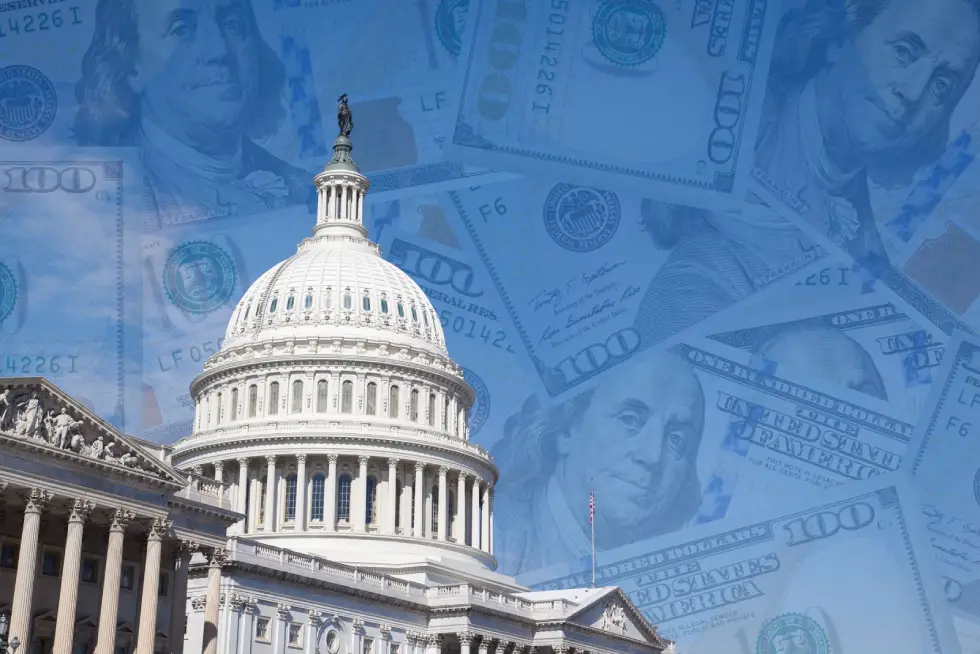Presidential election seasons are defined by the policies that candidates pitch, but the viability of those policies is not always within the grasp of the voting public, businesses and the rest of the economy. In a new University of Pennsylvania Wharton School series called “Policies That Work,” Wharton faculty experts assess the feasibility of the electoral promises made by former President Donald Trump and Vice President Kamala Harris.
The first panel of the series, held on October 23, 2024, focused on the federal debt, trade policies and the future of the US economy. Sharing their insights were Jeremy Siegel, professor emeritus of finance and Kent Smetters, professor of business economics and public policy and faculty director of the Penn Wharton Budget Model (PWBM), with session moderator Joao Gomes, professor of finance and senior vice dean of research, centers and academic initiatives.
Watch the full panel or read some key takeaways below:
Containing the federal debt
Both Trump, a Republican, and Harris, a Democrat, have promised tax incentives such as scrapping taxes on tips and Social Security payments and expanded child tax credits, even as the US federal debt is at record levels. “We can’t afford it. Even without either candidate, we are on an explosive path in terms of the debt,” Smetters said. Going that route in the present times would mean contraction in the economy and lower wages, which then would warrant tough corrective action, he warned. “While our fiscal house is burning down, both candidates are moving in more furniture.”
If raising taxes is the solution to fund those tax breaks, it would mean an “immediate and permanent” increase of 33% on all federal taxes. If spending cuts is the option, that would mean a 25% scythe across the board, including Social Security benefits. Those two scenarios are based on the current debt trajectory “and if we acted today. The longer we wait, the harder it becomes,” he said.
Siegel said excessive debt offerings by the government will raise the interest rate on long-term treasury bonds, which then would make everything more expensive, such as buying a home or financing for firms. At that point, the government will be forced to either cut spending and/or increase taxes, he added.
Outlook for interest rates
A Republican sweep where the party leads the House, the Senate and the presidency will enable “a free reign for goodies,” Siegel said. That could trigger a spike in interest rates, but rates may come down after “some soothing words” by those elected, he added. He did not foresee any big increase in interest rates in three to five years, or to levels that would hurt the economy.
Interest rates will have to respond when the federal debt grows to 175% of GDP, said Smetters. A Penn Wharton Budget Model brief noted that under current policy, the debt-to-GDP ratio would grow from 98% in 2023 to 150% by 2045; the debt becomes unsustainable beyond 200% of GDP, PWBM warned. “[Those high debt levels are] not mathematically possible, either without explicitly defaulting or implicitly defaulting,” Smetters said. Implicit default could occur either through monetization, which would result in higher inflation, or by pruning liabilities like Social Security and Medicare, he explained.
Siegel sees some light on that front. Foreigners own a third of U.S. debt, and the U.S.-owned portion is the remaining two-thirds, he pointed out. “The debt-to-world GDP ratio or the U.S. portion of [the debt-to-GDP] doesn’t look as scary. I see an ability to absorb the deficit that we have.”
Tax cuts and tarrifs
“Trump is way more expensive, and Harris is a lot cheaper,” Smetters said. “Nonetheless, neither candidate has proposed anything that both reduces debt and grows the economy.”
Trump wants to extend tax cuts to higher-income households and corporate income tax. Harris proposes to increase taxes on higher marginal payers and the corporate income tax. Many provisions of the 2018 Tax Cuts and Jobs Act, including individual income tax rate cuts, are temporary and will expire on December 21, 2025; the corporate tax cut from 35% to 21% is permanent.
If there is a split in control of Congress, there will be “huge negotiation on taxes,” Siegel said. “Everything will be on the table.” If the Republicans sweep Congress, they could extend all the tax cuts if the bond markets signal approval with interest rates, he predicted. “The long bond market tells politicians whether they have to act.”
Trump wants to impose stiff tariffs on imports (60% on Chinese goods and 20% on all others). A 20% tariff increase would cause the dollar to rise by about 10%, offsetting the price impact on goods to that extent, Siegel said. But higher import tariffs might provoke exporting countries to retaliate, he added. “If everyone retreats to barriers by taxes, that’s not going to help anyone.”
Such retaliation could cause a contraction of the economy, which in turn would lead to lower taxes than the higher revenues from tariff increases, Siegel continued. But the biggest cost of those tariffs will be felt more on the capital account than the current account, Smetters said. “When you have more debt, that also lowers capital flows across countries, which makes it harder for our government to sell debt,” he added.
Reading market expectations
“The stock market would prefer a Trump victory,” cheering his plan to extend tax cuts, including to long-term capital gains, Siegel said. But the bond market may not relish that (because of the impact on the federal debt and interest rates), he added. At the same time, “the market likes a legislative split; they like Congress to keep tabs on [the parties], he added. Smetters agreed: “The market wants gridlock. That would be the perfect outcome for them.”
“The other market that really matters for the average American is the housing market,” Gomes pointed out. Here, Harris’s proposed tax credits of up to $25,000 for first-time homebuyers is unrealistic because of supply shortages, Smetters said.
What would really help younger homebuyers is lower interest rates, made possible with a sustainable debt policy. “Think about doubling your house bill as you go from a 3% borrowing rate to a 6% or 7% borrowing rate. That is way more important than a $25,000 credit,” Smetters said. Home prices are up 45% since the COVID pandemic began, but along with the cost of an 80% mortgage, they have risen almost 150%, Siegel added.
Missing the math
- Harris’s proposal to avoid raising taxes for households that earn less than $400,000 annually is “mathematically impossible,” Smetters said. “There’s just not enough money at the high-income [levels].”
- Both parties have pledged not to touch Social Security, Medicare and Medicaid, including increasing the retirement age. “It’s not mathematically possible either,” said Smetters.
- Higher minimum wages also don’t evenly spread the gains. Both Smetters and Siegel said the earned income-tax credit (EITC) is far more effective in redistribution than higher minimum wages.
- Proposals by both parties to create more manufacturing jobs also seem to be overambitious. The idea is to “bring back the halcyon days of the 1960s, when manufacturing jobs were among the highest paying jobs,” Siegel said. “That’s just not the world today.”
“Both parties are so disconnected from reality that the stakes in the ground don’t make any sense,” Smetters said.
[Knowledge at Wharton first published this piece.]
The views expressed in this article are the author’s own and do not necessarily reflect Fair Observer’s editorial policy.
Support Fair Observer
We rely on your support for our independence, diversity and quality.
For more than 10 years, Fair Observer has been free, fair and independent. No billionaire owns us, no advertisers control us. We are a reader-supported nonprofit. Unlike many other publications, we keep our content free for readers regardless of where they live or whether they can afford to pay. We have no paywalls and no ads.
In the post-truth era of fake news, echo chambers and filter bubbles, we publish a plurality of perspectives from around the world. Anyone can publish with us, but everyone goes through a rigorous editorial process. So, you get fact-checked, well-reasoned content instead of noise.
We publish 2,500+ voices from 90+ countries. We also conduct education and training programs
on subjects ranging from digital media and journalism to writing and critical thinking. This
doesn’t come cheap. Servers, editors, trainers and web developers cost
money.
Please consider supporting us on a regular basis as a recurring donor or a
sustaining member.
Will you support FO’s journalism?
We rely on your support for our independence, diversity and quality.






